Abstract
BACKGROUND--Considerable variation exists in the use of antiasthmatic drugs in different counties in Sweden. The reasons for this variation are unknown. A study was performed to determine if there is an association between sales of antiasthmatic drugs and the prevalence of obstructive airway diseases in two adjoining Swedish counties. METHOD--The prevalence of asthma-associated symptoms in the county of Jämtland where there is high drug use, and the county of Gävleborg where it is lower, was assessed in 1990 by a postal questionnaire answered by 11,300 subjects. Three age groups were included: all 16 year olds, 13% of those aged 30-39 years, and 13% of 60-69 year olds. A total of 2100 subjects reporting airway symptoms in a questionnaire and 450 asymptomatic controls were further investigated at an interview with lung function tests and, in 500 cases, with a methacholine challenge. Asthma was diagnosed in subjects reporting a typical history or repeated episodes of dyspnoea and wheezing, or dry cough combined with reversibility in FEV1, variability in peak expiratory flow, or a PC20 value of < or = 4 mg/ml. RESULTS--The prevalence of current asthma was close to 8% in all age groups in Jämtland and significantly lower (close to 6%) in all age groups in the warmer, more industrialised and more densely populated county of Gävleborg. A gender difference with a higher prevalence in women was found in Gävleborg but not in Jämtland. There was no significant difference in the use of inhaled beta 2 stimulants among subjects with asthma in the two counties. Inhaled steroids were used more often in Jämtland. However, they were used regularly by fewer than 10% of asthmatic subjects in the two younger age groups. CONCLUSION--The differences in the use of antiasthmatic drugs in these two counties reflect a difference in the prevalence of obstructive airway disease.
Full text
PDF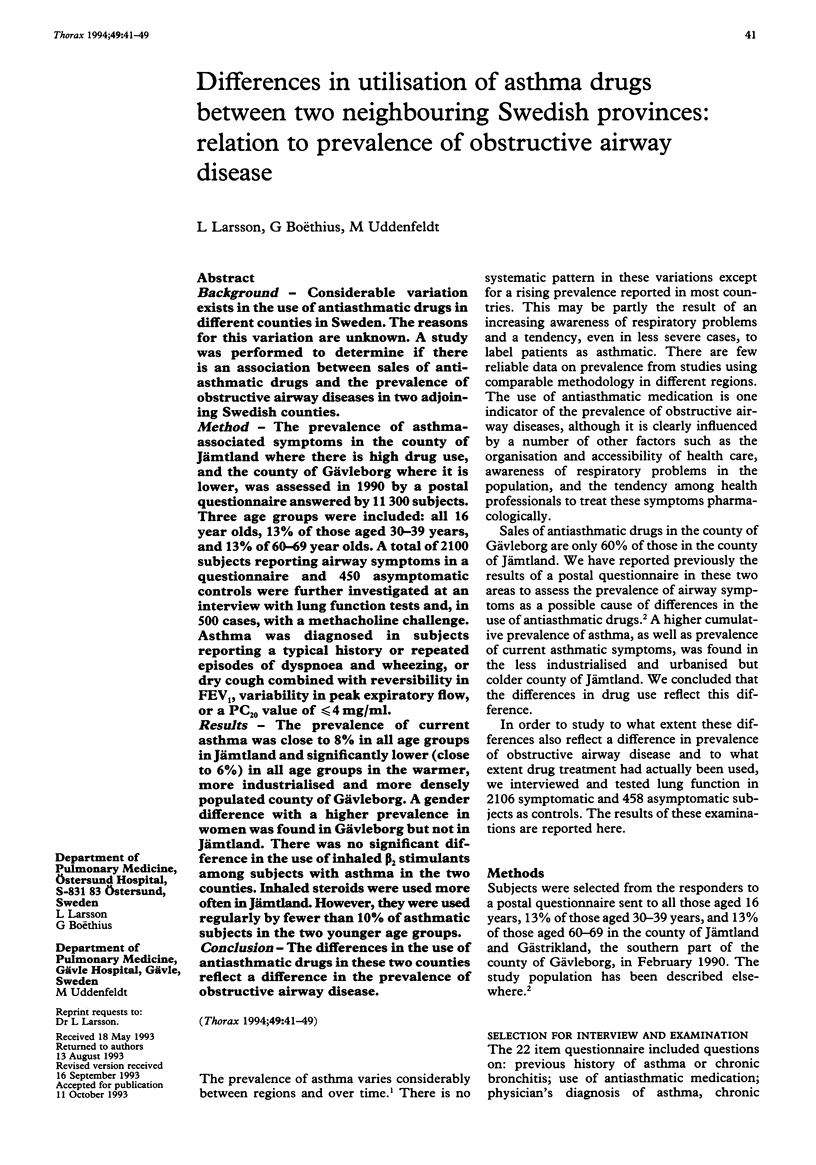
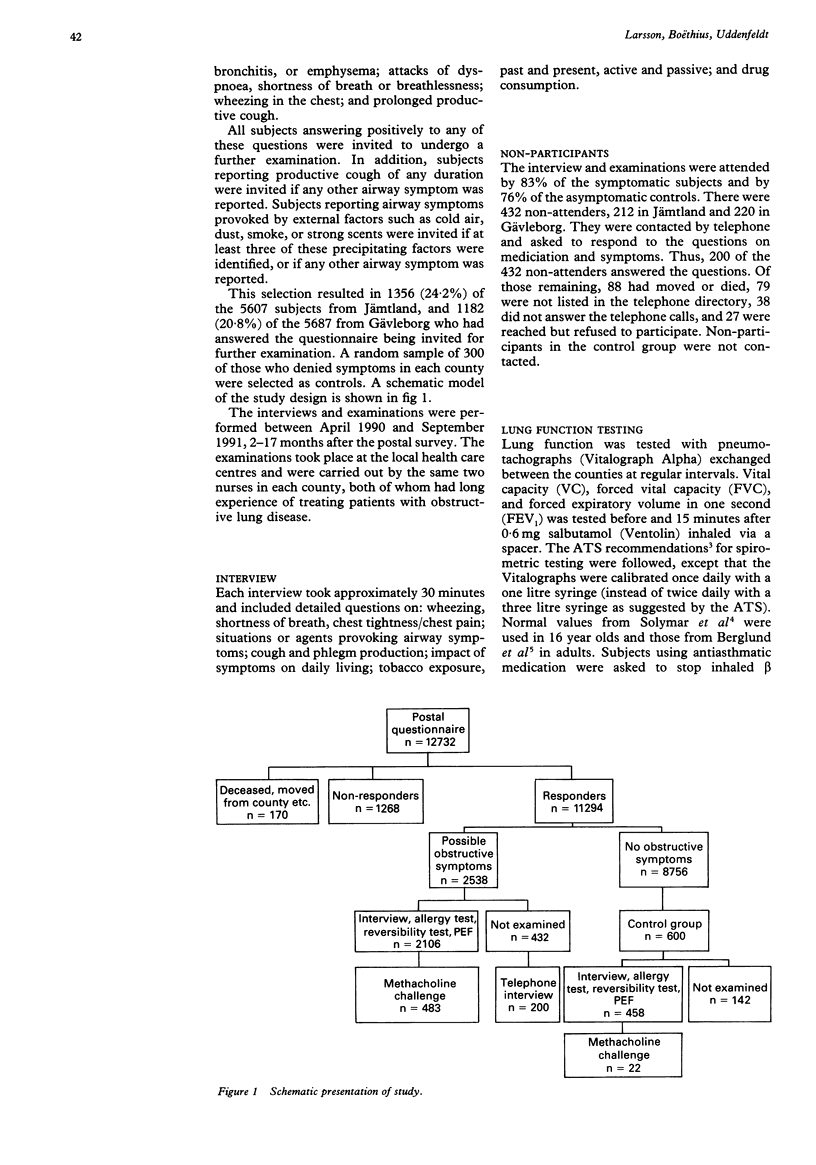
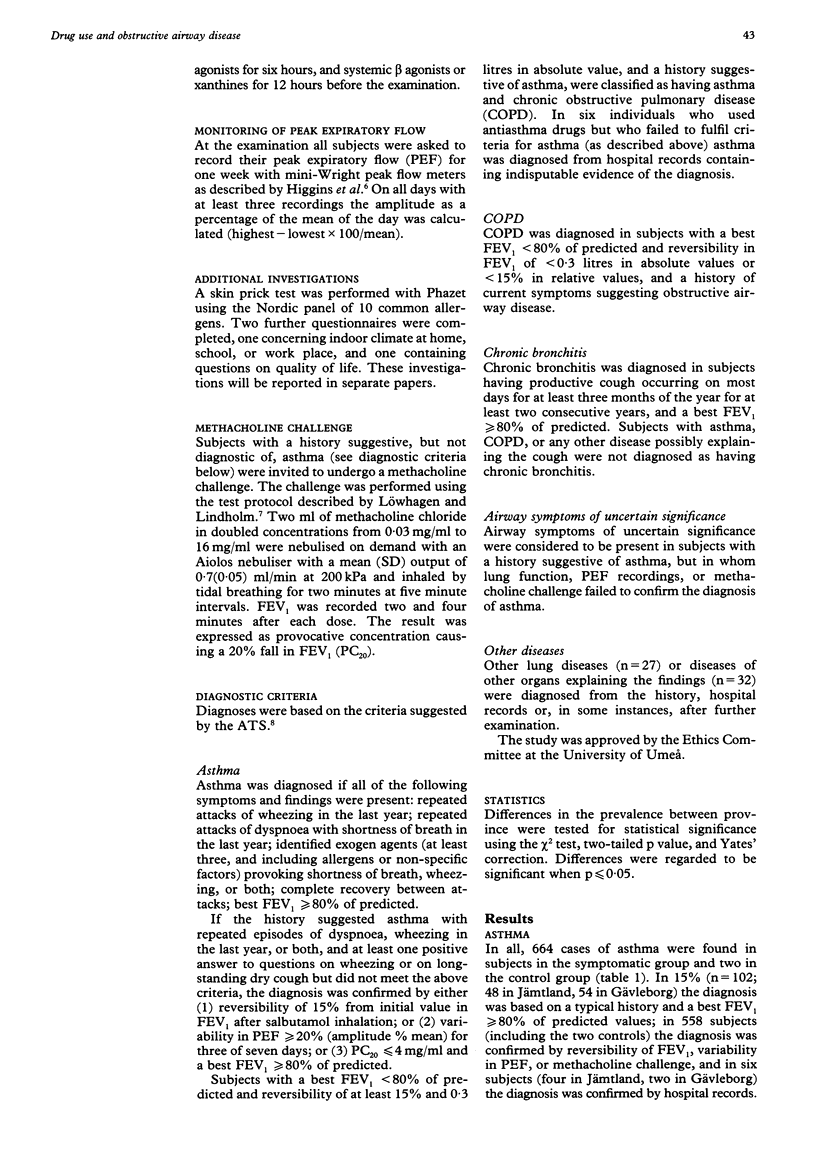
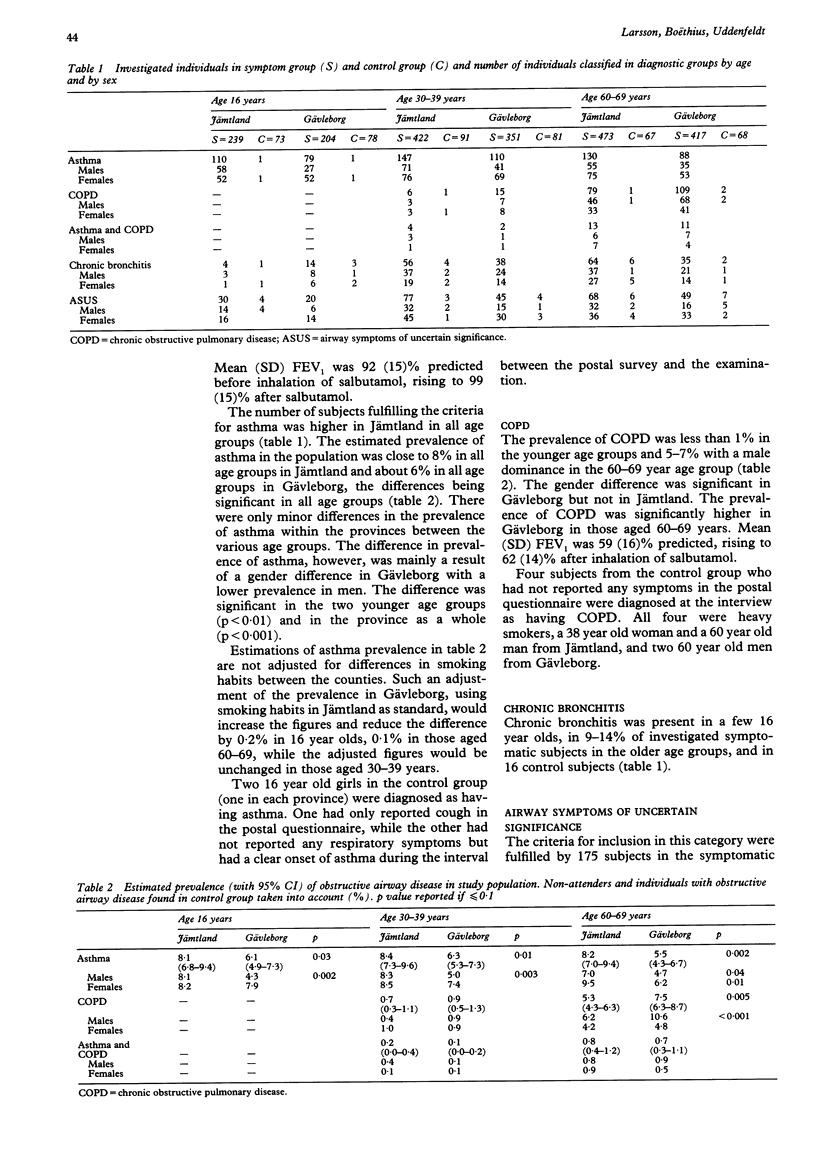
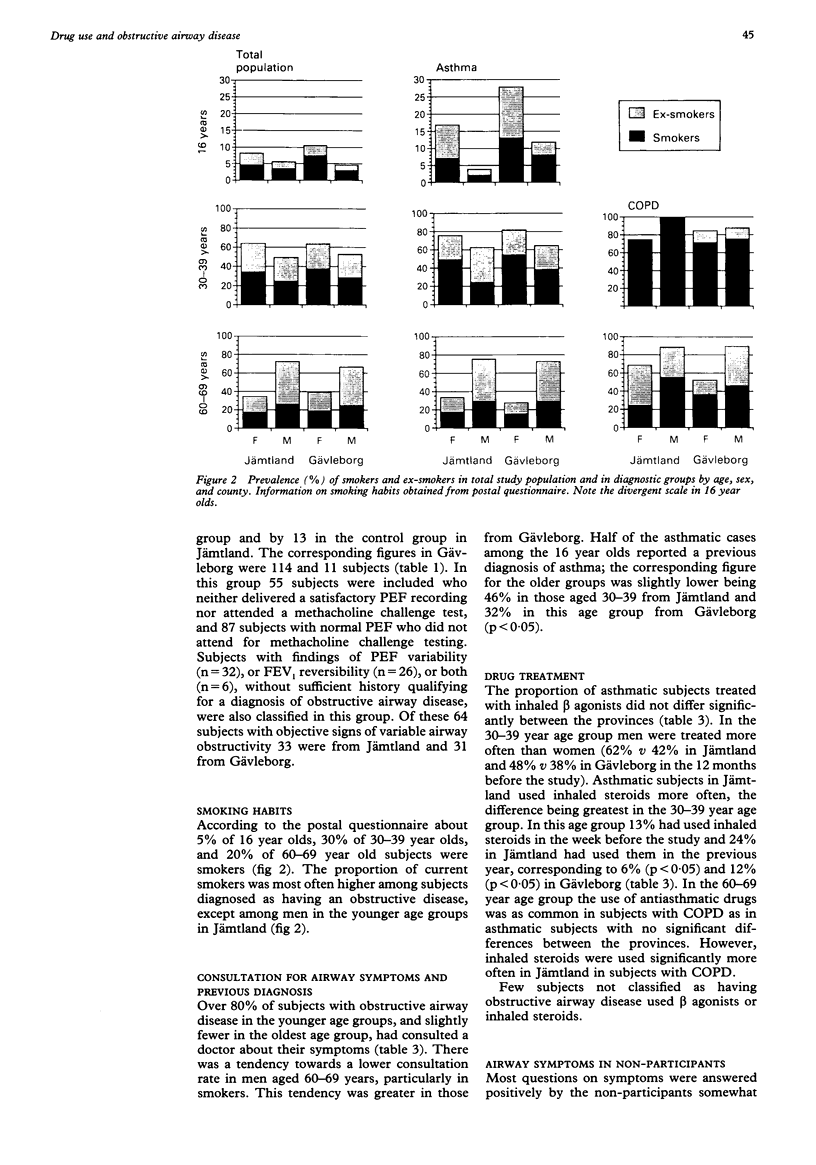
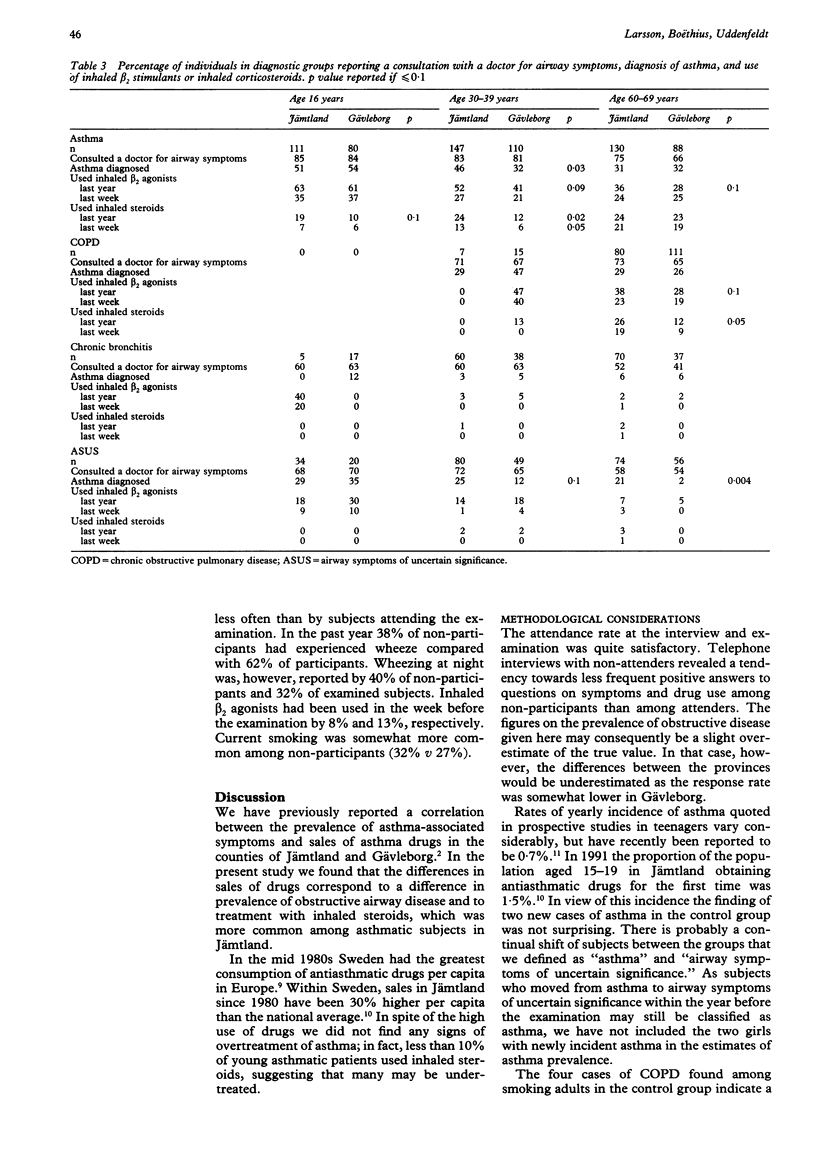
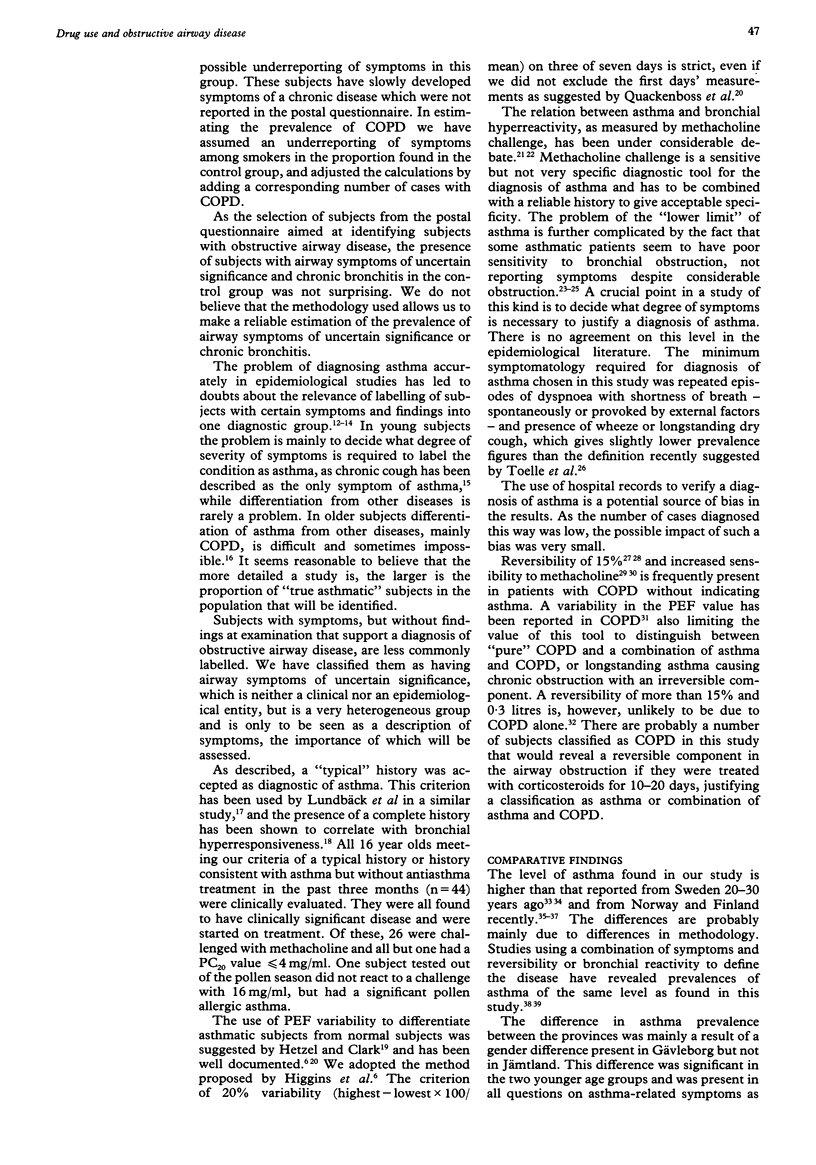
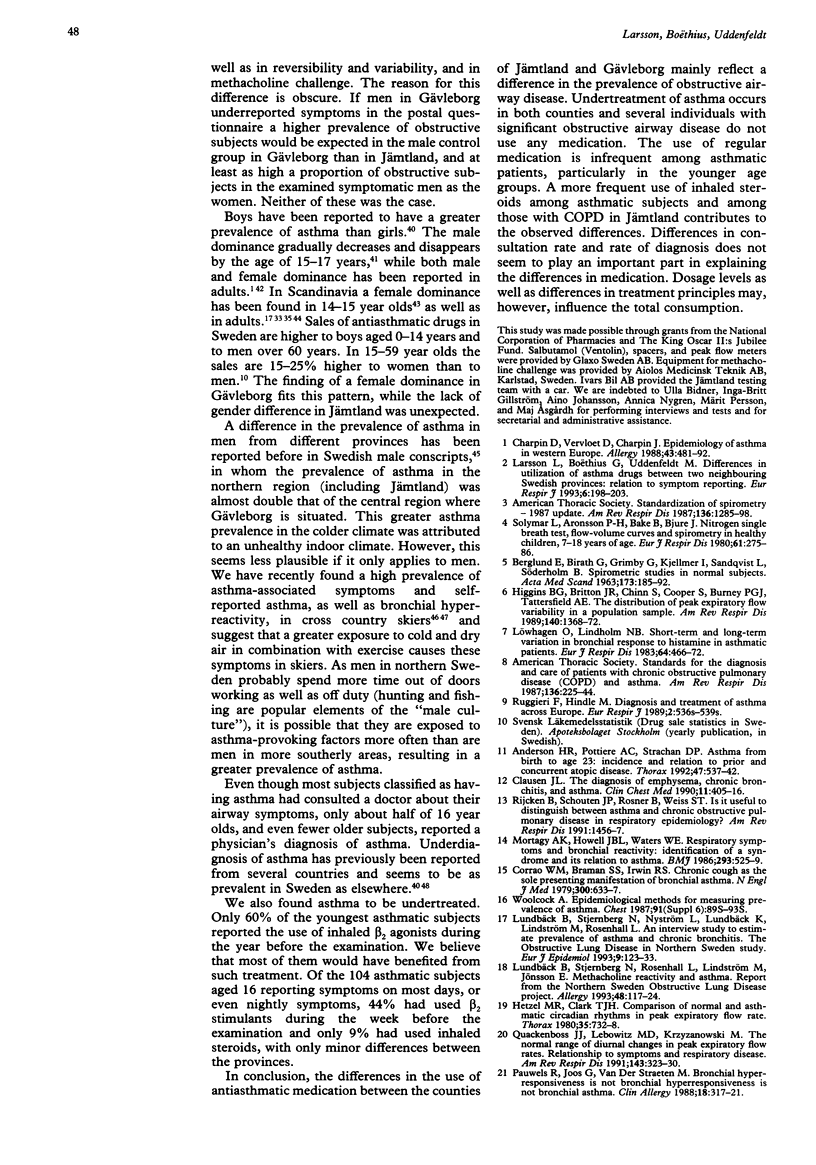
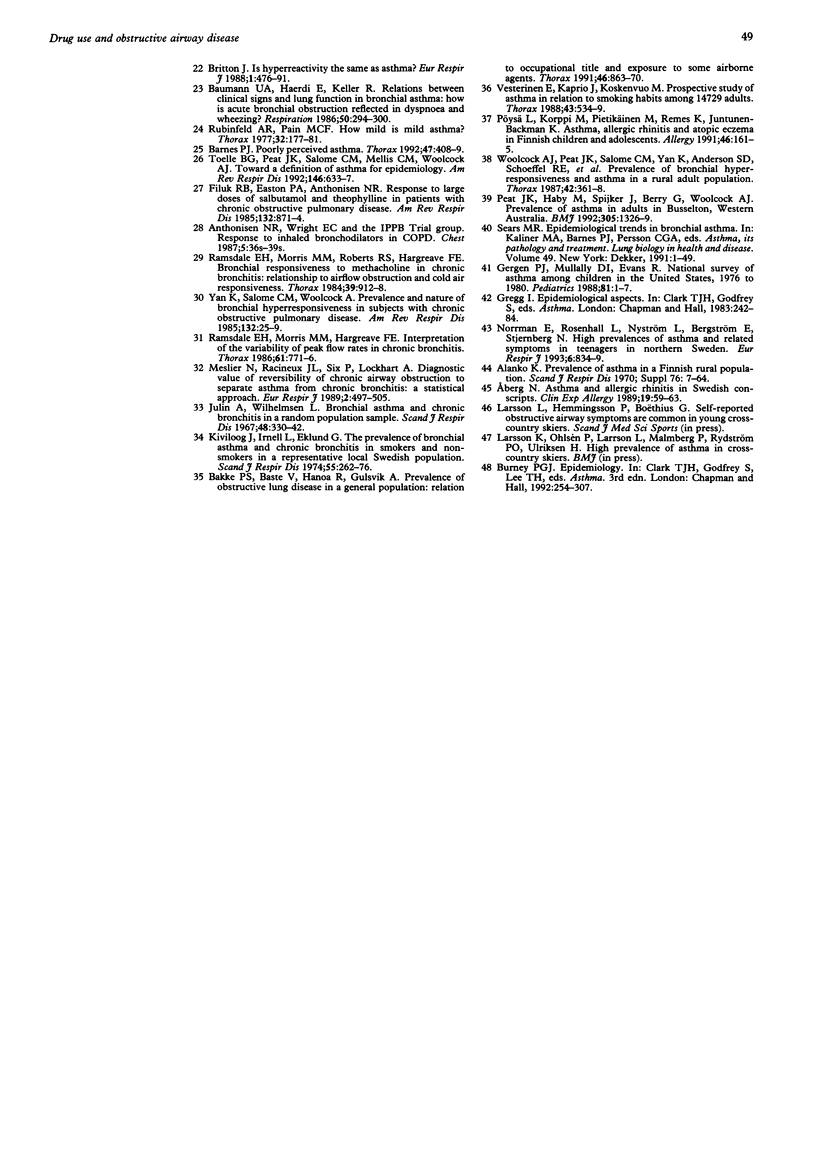
Images in this article
Selected References
These references are in PubMed. This may not be the complete list of references from this article.
- Aberg N. Asthma and allergic rhinitis in Swedish conscripts. Clin Exp Allergy. 1989 Jan;19(1):59–63. doi: 10.1111/j.1365-2222.1989.tb02345.x. [DOI] [PubMed] [Google Scholar]
- Anderson H. R., Pottier A. C., Strachan D. P. Asthma from birth to age 23: incidence and relation to prior and concurrent atopic disease. Thorax. 1992 Jul;47(7):537–542. doi: 10.1136/thx.47.7.537. [DOI] [PMC free article] [PubMed] [Google Scholar]
- Anthonisen N. R., Wright E. C. Response to inhaled bronchodilators in COPD. Chest. 1987 May;91(5 Suppl):36S–39S. [PubMed] [Google Scholar]
- BERGLUND E., BIRATH G., BJURE J., GRIMBY G., KJELLMER I., SANDQVIST L., SODERHOLM B. Spirometric studies in normal subjects. I. Forced expirograms in subjects between 7 and 70 years of age. Acta Med Scand. 1963 Feb;173:185–192. [PubMed] [Google Scholar]
- Bakke P. S., Baste V., Hanoa R., Gulsvik A. Prevalence of obstructive lung disease in a general population: relation to occupational title and exposure to some airborne agents. Thorax. 1991 Dec;46(12):863–870. doi: 10.1136/thx.46.12.863. [DOI] [PMC free article] [PubMed] [Google Scholar]
- Barnes P. J. Poorly perceived asthma. Thorax. 1992 Jun;47(6):408–409. doi: 10.1136/thx.47.6.408. [DOI] [PMC free article] [PubMed] [Google Scholar]
- Baumann U. A., Haerdi E., Keller R. Relations between clinical signs and lung function in bronchial asthma: how is acute bronchial obstruction reflected in dyspnoea and wheezing? Respiration. 1986;50(4):294–300. doi: 10.1159/000194941. [DOI] [PubMed] [Google Scholar]
- Charpin D., Vervloet D., Charpin J. Epidemiology of asthma in western Europe. Allergy. 1988 Oct;43(7):481–492. doi: 10.1111/j.1398-9995.1988.tb01624.x. [DOI] [PubMed] [Google Scholar]
- Clausen J. L. The diagnosis of emphysema, chronic bronchitis, and asthma. Clin Chest Med. 1990 Sep;11(3):405–416. [PubMed] [Google Scholar]
- Corrao W. M., Braman S. S., Irwin R. S. Chronic cough as the sole presenting manifestation of bronchial asthma. N Engl J Med. 1979 Mar 22;300(12):633–637. doi: 10.1056/NEJM197903223001201. [DOI] [PubMed] [Google Scholar]
- Filuk R. B., Easton P. A., Anthonisen N. R. Responses to large doses of salbutamol and theophylline in patients with chronic obstructive pulmonary disease. Am Rev Respir Dis. 1985 Oct;132(4):871–874. doi: 10.1164/arrd.1985.132.4.871. [DOI] [PubMed] [Google Scholar]
- Gergen P. J., Mullally D. I., Evans R., 3rd National survey of prevalence of asthma among children in the United States, 1976 to 1980. Pediatrics. 1988 Jan;81(1):1–7. [PubMed] [Google Scholar]
- Hetzel M. R., Clark T. J. Comparison of normal and asthmatic circadian rhythms in peak expiratory flow rate. Thorax. 1980 Oct;35(10):732–738. doi: 10.1136/thx.35.10.732. [DOI] [PMC free article] [PubMed] [Google Scholar]
- Higgins B. G., Britton J. R., Chinn S., Jones T. D., Jenkinson D., Burney P. G., Tattersfield A. E. The distribution of peak expiratory flow variability in a population sample. Am Rev Respir Dis. 1989 Nov;140(5):1368–1372. doi: 10.1164/ajrccm/140.5.1368. [DOI] [PubMed] [Google Scholar]
- Kiviloog J., Irnell L., Eklund G. The prevalence of bronchial asthma and chronic bronchitis in smokers and non-smokers in a representative local Swedish population. Scand J Respir Dis. 1974;55(5):262–276. [PubMed] [Google Scholar]
- Larsson L., Boëthius G., Uddenfeldt M. Differences in utilization of asthma drugs between two neighbouring Swedish provinces: relation to symptom reporting. Eur Respir J. 1993 Feb;6(2):198–203. [PubMed] [Google Scholar]
- Lundbäck B., Stjernberg N., Nyström L., Lundbäck K., Lindström M., Rosenhall L. An interview study to estimate prevalence of asthma and chronic bronchitis. The obstructive lung disease in northern Sweden study. Eur J Epidemiol. 1993 Mar;9(2):123–133. doi: 10.1007/BF00158781. [DOI] [PubMed] [Google Scholar]
- Lundbäck B., Stjernberg N., Rosenhall L., Lindström M., Jönsson E., Andersson S. Methacholine reactivity and asthma. Report from the Northern Sweden Obstructive Lung Disease Project. Allergy. 1993 Feb;48(2):117–124. doi: 10.1111/j.1398-9995.1993.tb00696.x. [DOI] [PubMed] [Google Scholar]
- Löwhagen O., Lindholm N. B. Short-term and long-term variation in bronchial response to histamine in asthmatic patients. Eur J Respir Dis. 1983 Aug;64(6):466–472. [PubMed] [Google Scholar]
- Meslier N., Racineux J. L., Six P., Lockhart A. Diagnostic value of reversibility of chronic airway obstruction to separate asthma from chronic bronchitis: a statistical approach. Eur Respir J. 1989 Jun;2(6):497–505. [PubMed] [Google Scholar]
- Mortagy A. K., Howell J. B., Waters W. E. Respiratory symptoms and bronchial reactivity: identification of a syndrome and its relation to asthma. Br Med J (Clin Res Ed) 1986 Aug 30;293(6546):525–529. doi: 10.1136/bmj.293.6546.525. [DOI] [PMC free article] [PubMed] [Google Scholar]
- Norrman E., Rosenhall L., Nyström L., Bergstrm E., Stjenberg N. High prevalence of asthma and related symptoms in teenagers in northern Sweden. Eur Respir J. 1993 Jun;6(6):834–839. [PubMed] [Google Scholar]
- Pauwels R., Joos G., Van der Straeten M. Bronchial hyperresponsiveness is not bronchial hyperresponsiveness is not bronchial asthma. Clin Allergy. 1988 Jul;18(4):317–321. doi: 10.1111/j.1365-2222.1988.tb02878.x. [DOI] [PubMed] [Google Scholar]
- Peat J. K., Haby M., Spijker J., Berry G., Woolcock A. J. Prevalence of asthma in adults in Busselton, Western Australia. BMJ. 1992 Nov 28;305(6865):1326–1329. doi: 10.1136/bmj.305.6865.1326. [DOI] [PMC free article] [PubMed] [Google Scholar]
- Pöysä L., Korppi M., Pietikäinen M., Remes K., Juntunen-Backman K. Asthma, allergic rhinitis and atopic eczema in Finnish children and adolescents. Allergy. 1991 Apr;46(3):161–165. doi: 10.1111/j.1398-9995.1991.tb00564.x. [DOI] [PubMed] [Google Scholar]
- Pöysä L., Korppi M., Pietikäinen M., Remes K., Juntunen-Backman K. Asthma, allergic rhinitis and atopic eczema in Finnish children and adolescents. Allergy. 1991 Apr;46(3):161–165. doi: 10.1111/j.1398-9995.1991.tb00564.x. [DOI] [PubMed] [Google Scholar]
- Quackenboss J. J., Lebowitz M. D., Krzyzanowski M. The normal range of diurnal changes in peak expiratory flow rates. Relationship to symptoms and respiratory disease. Am Rev Respir Dis. 1991 Feb;143(2):323–330. doi: 10.1164/ajrccm/143.2.323. [DOI] [PubMed] [Google Scholar]
- Ramsdale E. H., Morris M. M., Hargreave F. E. Interpretation of the variability of peak flow rates in chronic bronchitis. Thorax. 1986 Oct;41(10):771–776. doi: 10.1136/thx.41.10.771. [DOI] [PMC free article] [PubMed] [Google Scholar]
- Ramsdale E. H., Morris M. M., Roberts R. S., Hargreave F. E. Bronchial responsiveness to methacholine in chronic bronchitis: relationship to airflow obstruction and cold air responsiveness. Thorax. 1984 Dec;39(12):912–918. doi: 10.1136/thx.39.12.912. [DOI] [PMC free article] [PubMed] [Google Scholar]
- Revelly J. P., Feihl F., Liebling T., Perret C. Time constant histograms from the forced expired volume signal: a clinical evaluation. Eur Respir J. 1989 Jun;2(6):536–542. [PubMed] [Google Scholar]
- Rijcken B., Schouten J. P., Rosner B., Weiss S. T. Is it useful to distinguish between asthma and chronic obstructive pulmonary disease in respiratory epidemiology. Am Rev Respir Dis. 1991 Jun;143(6):1456–1457. doi: 10.1164/ajrccm/143.6.1456. [DOI] [PubMed] [Google Scholar]
- Rubinfeld A. R., Pain M. C. How mild is mild asthma? Thorax. 1977 Apr;32(2):177–181. doi: 10.1136/thx.32.2.177. [DOI] [PMC free article] [PubMed] [Google Scholar]
- Solymar L., Aronsson P. H., Bake B., Bjure J. Nitrogen single breath test, flow-volume curves and spirometry in healthy children, 7-18 years of age. Eur J Respir Dis. 1980 Oct;61(5):275–286. [PubMed] [Google Scholar]
- Tattersfield A. E., Higgins B. G. Bronchial reactivity in the community. Eur Respir J. 1988 May;1(5):476–478. [PubMed] [Google Scholar]
- Toelle B. G., Peat J. K., Salome C. M., Mellis C. M., Woolcock A. J. Toward a definition of asthma for epidemiology. Am Rev Respir Dis. 1992 Sep;146(3):633–637. doi: 10.1164/ajrccm/146.3.633. [DOI] [PubMed] [Google Scholar]
- Vesterinen E., Kaprio J., Koskenvuo M. Prospective study of asthma in relation to smoking habits among 14,729 adults. Thorax. 1988 Jul;43(7):534–539. doi: 10.1136/thx.43.7.534. [DOI] [PMC free article] [PubMed] [Google Scholar]
- Woolcock A. J. Epidemiologic methods for measuring prevalence of asthma. Chest. 1987 Jun;91(6 Suppl):89S–92S. doi: 10.1378/chest.91.6_supplement.89s. [DOI] [PubMed] [Google Scholar]
- Woolcock A. J., Peat J. K., Salome C. M., Yan K., Anderson S. D., Schoeffel R. E., McCowage G., Killalea T. Prevalence of bronchial hyperresponsiveness and asthma in a rural adult population. Thorax. 1987 May;42(5):361–368. doi: 10.1136/thx.42.5.361. [DOI] [PMC free article] [PubMed] [Google Scholar]
- Yan K., Salome C. M., Woolcock A. J. Prevalence and nature of bronchial hyperresponsiveness in subjects with chronic obstructive pulmonary disease. Am Rev Respir Dis. 1985 Jul;132(1):25–29. doi: 10.1164/arrd.1985.132.1.25. [DOI] [PubMed] [Google Scholar]



